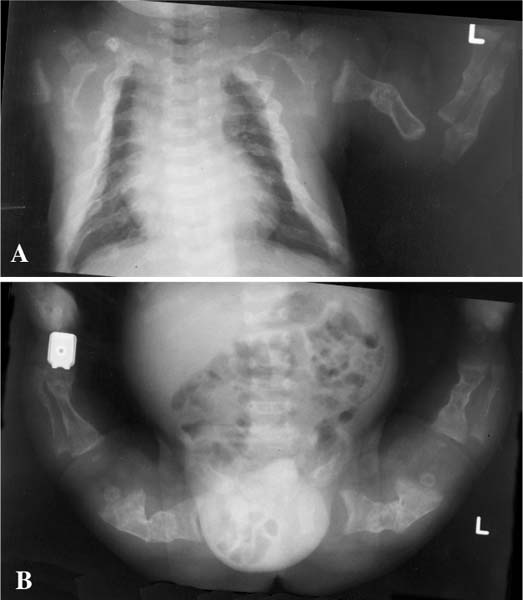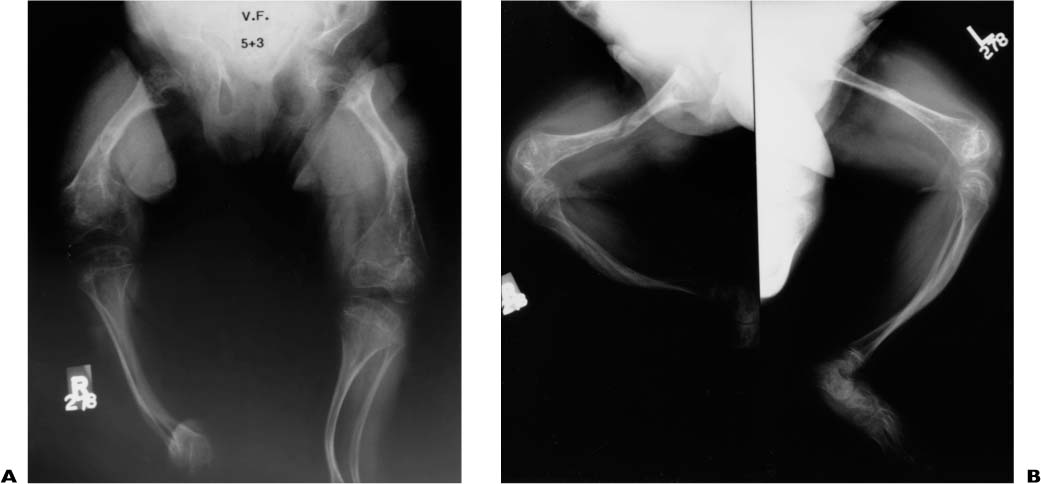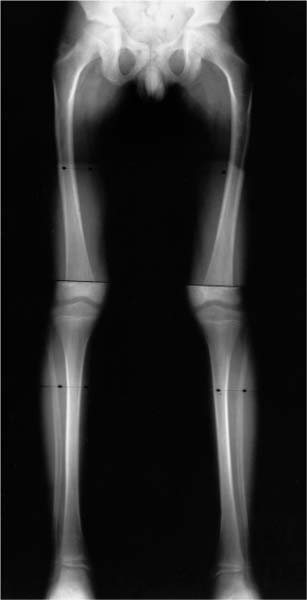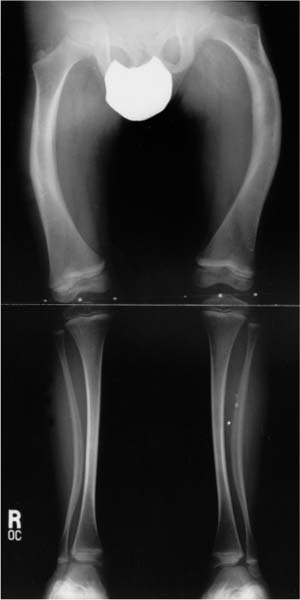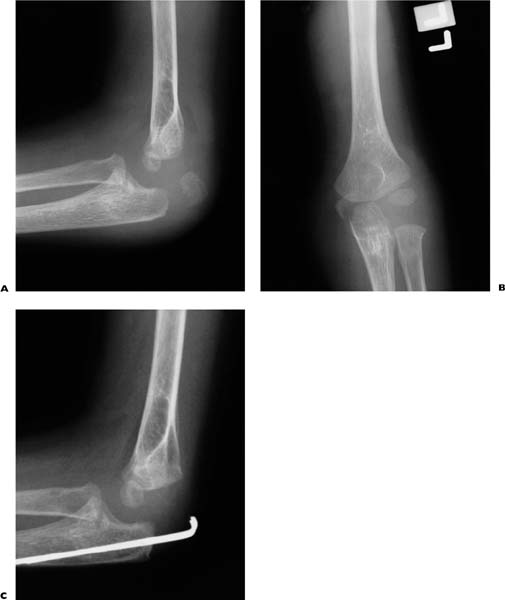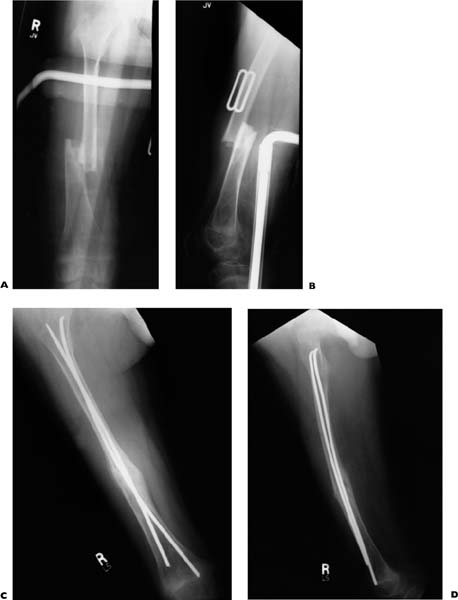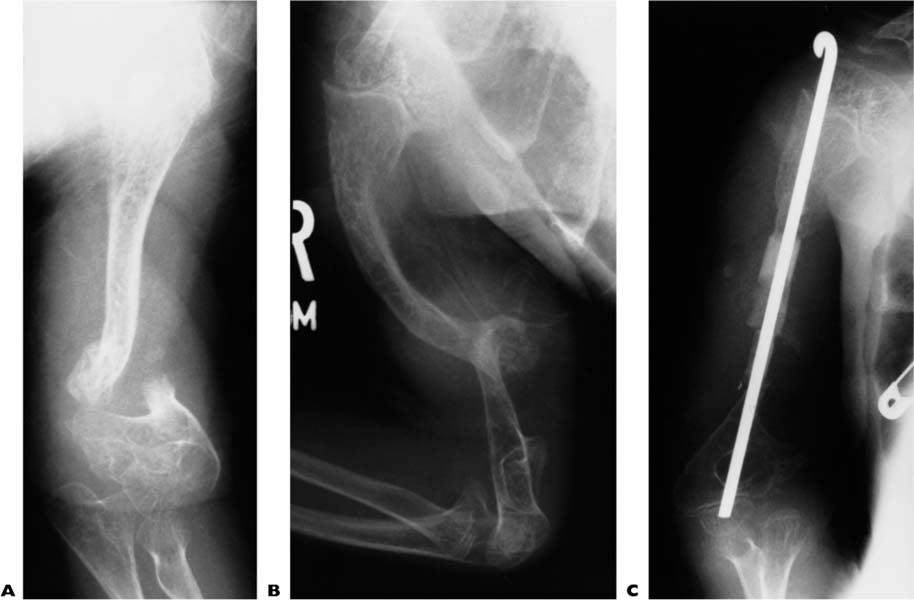Chapter 12 Osteogenesis imperfecta is a heterogeneous group of inherited disorders caused by defective collagen synthesis, often leading to frequent fractures and the development of progressive deformity of the long bones. Osteopenia is a consistent finding with this disorder. Even in the most mildly involved patients, the bone mineral density averages approximately 30% lower than normal.1,2 In the early stages of the disease, fractures are usually managed nonoperatively. Operative intervention becomes necessary when recurring fractures or progressive deformity begin to limit function. Of historical note, Seedorff3 suggested that Ivar Benlos (also known as Ivar the Boneless), who lived in the last quarter of the ninth century, may have been afflicted with osteogenesis imperfecta. Ivar, eldest son of the Danish king Regnar Lodbrog, is said to have had legs as soft as cartilage. Unable to walk, he had to be carried into battle on a shield. According to Tsipouras,4 complete verification of Ivar’s diagnosis is impossible because his skeletal remains are no longer available for study, having been exhumed and burned by William the Conqueror. More tangible evidence of an early case of osteogenesis imperfecta can be found in an Egyptian mummy dating from about 1000 years B.C.5 The mummy had a tam-o’-shanter-shaped skull, radiographs of which revealed numerous Wormian bones. The long bones were deformed, with those of the lower extremity showing marked anterolateral bowing. Moreover, the teeth were amber in color, and the roots were disproportionately smaller than the crowns, both findings suggestive of dentinogenesis imperfecta. In 1788, Eckmann provided what is now generally recognized as the first scholarly account of hereditary bone fragility through three generations.3,4 He termed this condition osteomalacia congenita. Seedorff3 wrote that osteogenesis imperfecta should be called Eckmann’s disease, “if at all one wants to practice the bad custom of naming a disease by its first describer.” Sillence et al6,7 classified osteogenesis imperfecta into four distinct groups based on phenotypic features, radiologic appearance of the bones, and the mode of inheritance (Table 12–1). Their system is currently the most widely used.
INTERNAL FIXATION IN PATIENTS
WITH OSTEOGENESIS IMPERFECTA
CLASSIFICATION SYSTEMS
Type | Characteristics |
|---|---|
I | Autosomal dominant inheritance |
| Mildest form |
| Blue sclerae |
| Mild to moderate bone fragility and deformity |
| Mild to moderate short stature |
| Subtype A: dentinogenesis absent |
| Subtype B: dentinogenesis present |
II | Autosomal recessive inheritance or new dominant mutation |
| Extreme bone fragility and deformity |
| Lethal in perinatal or newborn period |
III | Autosomal recessive inheritance or new dominant mutation |
| Normal sclerae |
| Severe bone fragility and progressive deformity |
| Severe short stature |
| May or may not have dentinogenesis |
| imperfecta |
IV | Autosomal dominant inheritence |
| Normal sclerae |
| Bone fragility and deformity more marked than |
| type I |
| Short stature more marked than type I |
| Subtype A: dentinogenesis absent |
| Subtype B: dentinogenesis present |
FIGURE 12–1 (A) Radiograph of a newborn with type II osteogenesis imperfecta who died shortly after birth. Fractures of the upper extremity and a beaded appearance of the ribs are apparent. (B) Radiograph of the lower extremity, showing a crumpled, concertina-like appearance of the femora as well as fractures of the tibiae.
Types II and III are severe forms of the disorder. Type II osteogenesis imperfecta is characterized by extremely fragile bone, often resulting in perinatal or early infant death. Radiographs show crumpled (concertina-like) femora, angulated fractures of the tibia, fractures of the shafts of the upper limbs, platyspondyly, and a beaded appearance of the ribs (Fig. 12–1). Type III osteogenesis imperfecta causes severe bone fragility, and multiple fractures are usually present at birth. With age, these patients develop severely shortened stature and progressive deformity of the limbs and spine (Fig. 12–2).
Types I and IV osteogenesis imperfecta are milder forms of the disorder, with type I representing the mildest. Patients with type I osteogenesis imperfecta have distinctly blue sclera and generally fewer fractures, with less severe deformity of the limbs and spine than those with type IV (Fig. 12–3). In contrast, type IV is a moderately severe form of the disorder with wide phenotypic variability. Patients with type IV osteogenesis imperfecta have shortened stature and deformity of the long bones and spine, with intermediate severity between those of types I and III (Fig. 12–4). Managing fractures and deformities in type III and IV patients presents the greatest challenge to the physician.8
Shapiro9 proposed another classification scheme that may be used to predict the survival and walking ability of patients with osteogenesis imperfecta (Table 12–2). In this system, patients are classified according to the time of the initial fracture and the radiographic appearance of their long bones and ribs. Patients who have intrauterine or birth fractures are classified as osteogenesis imperfecta congenita (OIC). These are further subdivided into subgroups A and B. In subgroup A, radiographs show short, broad, crumpled femurs and ribs, whereas in subgroup B, radiographs show bones with normal contours. In contrast to OIC, individuals who sustain their first fracture after birth are classified as osteogenesis imperfecta tarda (OIT). These patients are further subdivided into subgroup A, who sustain their first fracture before walking has begun, and subgroup B, who suffer their first fracture after walking has begun.
Shapiro9 found that survival was poor in patients classified as OIC-A. In his report, 14 of 16 OIC-A patients died before 2 years of age. By comparison, survival of OIC-B patients was much better; however, many required a wheelchair for mobility. The prognosis for ambulation was better in OIT patients; that is, two thirds of OIT-A patients and all OIT-B patients were ambulatory.
FIGURE 12–2 (A,B) Anteroposterior and lateral radiographs of a 5-year-old girl with type III osteogenesis imperfecta, showing deformity and narrowing of the long bones of the lower extremities.
FIGURE 12–3 Radiograph of a 9-year-old boy with type I osteogenesis imperfecta. Osteopenia is present, but deformity of the long bones is minimal.
FIGURE 12–4 Radiograph of a 6-year-old boy with type IV osteogenesis imperfecta, showing moderate bowing deformity of the long bones of the lower extremities.
Type | Characteristics |
|---|---|
OIC | Intrauterine fractures and/or fractures at birth |
| Subtype A: |
| Short, broad, and crumpled femurs |
| Small, bell-shaped rib cage |
| Multiply fractured, short ribs |
| Subtype B: |
| Long bones of normal shape and length |
| Ribs of normal length, narrow or normal width, less extensive fractures |
| Rib cage with normal configuration |
OIT | Initial fracture after birth |
| Subtype A: |
| First fracture before walking |
| Long bones and ribs normal in length, but somewhat narrow and osteopenic |
| Rib cage normal |
| Subtype B: |
| First fracture after walking began |
| Long bones of normal shape, width, and length |
| Rib cage normal |
Data from Shapiro.9
FRACTURE MANAGEMENT
Closed methods of treatment are the mainstay of fracture management in children with osteogenesis imperfecta.8,10 Fractures usually heal at a normal rate, often with abundant callus that bears the same abnormal quality as the surrounding bone. Fractures through a deformed bone may provide an opportunity to obtain a straighter alignment. In managing fractures of these patients, it is important to minimize the disuse osteopenia that is associated with immobilization. Therefore, the duration of immobilization should be as short as possible. Early mobilization may be facilitated by using lightweight casts or splints.
In children with the milder forms of the disease, certain fractures are best treated using internal fixation. Olecranon apophyseal fractures in children with osteogenesis imperfecta may be treated using two parallel intramedullary Kirshner wires and a figure-of-eight tension band of stainless steel wire or absorbable suture11 (Fig. 12–5). Femoral fractures in older children and adolescents with the more mild forms of osteogenesis imperfecta may be managed by intramedullary nailing in selected cases (Fig. 12–6). The use of load-bearing devices, such as external fixators, is probably best avoided because these devices may impair the formation of bridging callus at the fracture site.
Although rare in normal children, a nonunion of a fracture may occur in a child with osteogenesis imperfecta, usually in those with the more severe form of the disorder.12 A nonunion is often associated with repeated fractures through a progressively bowed region of a long bone. When nonunion occurs in the upper extremity, it may limit the ability of the patient to transfer and can compromise hand function. A nonunion in the lower extremity can impair mobility. Treatment consists of excision of the nonunion, intramedullary nailing, and bone grafting (Fig. 12–7).
MANAGEMENT OF LONG BONE DEFORMITY
INDICATIONS FOR OPERATIVE TREATMENT
In children with osteogenesis imperfecta, the disuse osteopenia and residual deformity that generally follows immobilization of a fracture increases the risk of a subsequent fracture and further deformity, creating a vicious cycle that can be stopped only by operative treatment. Most authors agree that indications for operative treatment in children with osteogenesis imperfecta include recurrent fractures and progressive deformity that impair function. The indications for surgery may be influenced by the severity of the disease. Specifically, in children with type III disease, Cole13 has recommended that surgery should be reserved for the prevention of repeated fractures and should not be performed for the correction of deformity alone in patients who are relatively free of fractures.
Some authors have proposed that surgical treatment will favorably influence motor development14 and will allow previously nonambulatory children to walk.15 In contrast, Millar16 suggested that the severity of involvement was more important than surgery in determining the probability of ambulation and recommended that ambulation should not be the primary objective of surgery. Both Cole13 and Shapiro9 have noted that the prognosis for independent ambulation was poor in patients with severe disease. Their observation was confirmed by Daley and colleagues17 who found that only 1 of 29 children who had type III osteogenesis imperfecta became a walker. Furthermore, their study suggested that intramedullary rodding had no major influence on motor development. In summary, although one may enhance the potential for walking in some children with osteogenesis imperfecta by correcting deformity and improving the stability of the long bones, the goal of achieving ambulation may not be realistic for those with severe disease.
In children with severe osteogenesis imperfecta, progressive deformity of the long bones of the upper extremity commonly occurs. However, the upper extremities generally function quite well despite significant deformity, and thus there is usually no need for surgical correction. Still, surgery may be indicated for deformity that interferes with function or is associated with frequent fractures.18,19
FIGURE 12–5 (A,B) Anteroposterior and lateral radiographs of a 4-year-old boy with type I osteogenesis imperfecta, showing an olecranon apophyseal fracture. (C) The fracture was treated by open reduction and internal fixation using two parallel intramedullary Kirschner wires and a figure-of-eight tension band of absorbable suture.
The optimum age at which to begin operative management in children with osteogenesis imperfecta is controversial. Traditionally, deformity that may occur following closed treatment is accepted until the patient reaches the age of 5 years, after which corrective osteotomies are performed.8 This approach minimizes the number of operative procedures that will be required over the lifetime of the patient. Operative intervention in infancy with “percutaneous” and “semi-closed” intramedullary rodding techniques has been described for the management of severely involved patients.20–22 These authors argue that in these very young patients, the benefits of deformity correction and internal stabilization of the long bones outweigh the risks of repeated procedures. This issue is still subject to controversy. As a result, the timing of operative management varies among practitioners based on their experience and philosophy.
FIGURE 12–6 (A,B) Anteroposterior and lateral radiographs of an 11-year-old boy with type IV osteogenesis imperfecta, showing a femur fracture. (C,D) Four months after closed reduction and stabilization using flexible intramedullary nails, radiographs show good bridging callus at the fracture site.
FIGURE 12–7 (A,B) Anteroposterior and lateral radiographs of an 8-year-old girl with type III osteogenesis imperfecta, showing a nonunion of the distal humerus. (C) The nonunion was excised, the remaining deformity was corrected by multiple osteotomies, and an intramedullary rod was inserted.
SURGICAL OPTIONS FOR CORRECTION OF LONG BONE DEFORMITY
In 1959, Sofield and Millar23 described fragmentation, realignment, and intramedullary nail fixation for the treatment of children who have osteogenesis imperfecta. They found that this procedure decreased the frequency and discomfort of fractures and corrected deformity. However, in time, the patients would outgrow the implant, allowing angulation or fracture to occur at levels of unsupported bone. The time between insertion and replacement of the nail averaged between 2 and 3 years in most series.23–27
To address this problem, in 1963, Bailey and Dubow28
Stay updated, free articles. Join our Telegram channel

Full access? Get Clinical Tree


